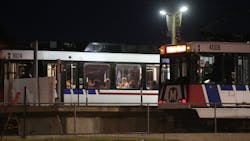There are many reasons why people should choose public transit; from the positive impact on the environment to the fact that, as a mode of travel, transit is several times safer than a personal vehicle.
However, while the amount of rail systems increased significantly during the past three decades, ridership in some sectors of the United States has seen a slight decline in recent years. According to numbers published in the American Public Transportation Association’s (APTA) 2019 Public Transportation Fact Book, light rail and streetcar ridership increased by 0.9 percent for the year 2016-2017, but commuter and hybrid rail ridership declined by 0.4 percent during the same period. The 2019 Fact Book also notes that rail modes make up the majority of the total passenger miles taken during that time frame.
Rail systems have fought long and hard budget battles, with mixed results, as they attempt to address the large backlog of state of good repair work required to keep capital intensive rail infrastructure in optimal shape, which leads to more reliable service. While service is one factor that determines why people should choose rail transit, another less concrete factor may play into why they do not make that choice: Perception.
A 2013 study by researchers at the University of California, Irvine, examined transit use among a small segment of resident in south Los Angeles, Calif. The study determined that within the sliver of residents evaluated, transit attitudes and safety concerns were related to transit use.
The study authors wrote:
Our analysis indicates that two [Perception-Intention-Adaptation] constructs, attitudes toward public transportation and concerns about personal safety, significantly improved the model fit and were robust predictors of transit use, independent of built environment factors such as near-residence street network connectivity and transit service level. Results indicate the need for combined policy approaches to increasing transit use that not only enhance transit access, but also target attitudes about transit service and perceptions of crime on transit.
Recent initiatives from transit agencies with rail systems indicate rider perceptions in addition to service delivered is actively being addressed through implementation of advanced technology, improved rider outreach efforts and even the simple act of keeping systems clean.
Clean and well-lit systems
Bay Area Rapid Transit (BART) tracks several indicators meant to evaluate passenger views of the system in addition to the usual on-time performance and vehicle uptime. The ratings are compiled using rider responses to BART’s Passenger Environment Survey (PES) questionnaires that are available in several languages. BART collects between 5,000 and 6,000 questionnaires every quarter to keep tabs on its passengers’ opinions on the transit environment.
BART reported in August that the station cleanliness rider scores showed marked improvement in the quarterly performance report for the fourth quarter of FY 2019. BART says it’s the biggest year over year ratings improvement was for elevator cleanliness, with 58.1 percent of riders giving a “good” or “excellent” rating, up from 42.8 percent for the same quarter of last year.
BART credits the increase to the elevator attendant program launched in April of 2018 at the Powell Street and Civic Center stations. The program has virtually eliminated inappropriate behavior in these station elevators and in July, the BART Board of Directors voted to expand the program to the Embarcadero and Montgomery Street stations as early as this fall.
Other increases were seen in the percentage of riders positively rating the cleanliness of station platforms and restroom cleanliness. BART also saw improvements in three new categories meant to address quality of life issues and include cleanliness of the concourse, escalator cleanliness and stairwell cleanliness.
For BART’s new General Manager Bob Powers, improving cleanliness is part of his plan to put riders first.
“We are committed to improving the customer experience through cleaner stations and have revamped our approach to include focused overnight cleanings of our busiest stations,” said Powers. “We believe our efforts are reflected in these latest ratings and we will continue to prioritize riders with our plan to hire 15 new cleaners over the next six months.”
Halfway across the U.S., the St. Clair County Transit District (SCCTD), in partnership with Ameren Illinois, recently wrapped up a lighting project that will not only improve safety at the MetroLink stations in Illinois but will also reduce monthly electric costs by approximately 60 percent.
SCCTD says by upgrading outdoor lighting from halogen to LED at all 11 Metrolink stations in Illinois, rider safety and security is improved, as is efficiency.
“Our number one priority is our riders. This program demonstrates that priority while being fiscally responsible as an agency,” said Herb Simmons, chair of the St. Clair County Transit District Board of Trustees.
Replacing aging outdoor halogen lights with brighter LED bulbs will boost night-time visibility for patrons using the MetroLink system and parking lots and, as SCCTD Managing Director Ken Sharkey noted, the parking lot security cameras as capturing better images that can help law enforcement patrolling the facilities.
“This project is a perfect example of the power of partnerships, and how working together, we can make an investment that both saves taxpayer money and improves the comfort, safety and overall transit experience for our customers,” said Taulby Roach, president and CEO of Bi-State Development.
Positive on-board experience
There are several examples of transit systems across North America instituting public awareness campaigns that aim to reduce offences experienced by riders. Washington Metropolitan Area Transit Authority (WMATA) launched a series of ads this past April developed with Stop Street Harassment and Collective Action for Safe Spaces (CASS) to stop harassment. The campaign featured the message “You can help STOP harassment” with four simple strategies that spell out STOP – Sidetrack, Tell, Observe and Postpone.
The campaign is part of an ongoing effort that began in 2012 to raise awareness and combat sexual harassment in WMATA’s system. In a report last year, Understanding Sexual Harassment on Public Transportation, WMATA found that familiarity with the campaign increased the likelihood of reporting incidents of harassment.
“Harassment of any kind is unacceptable in the Metro system,” said Metro Transit Police Chief Ron Pavlik. “It’s important for riders to have the tools to know how to report harassment and how they can help if they see it happening.”
In the Tampa, Fla., area, the Hillsborough Area Regional Transit Authority (HART) launched its Ride with Respect campaign in early August to promote positive on-board experiences for both operators and riders.
The campaign educates riders, operators and the community of system safety and security rules, riding etiquette and includes operator customer service training and a social media campaign aimed to elevate the transit operator position to the level of first responders.
HART explains that central to the Ride with Respect campaign is a series of emotional short vignettes following HART operators throughout their day, displaying family interactions, hobbies, devotions and other life elements to help customers and the general public better connect with HART staff.
"Every day, more than 300 transit professionals and 34,000 customers share a space on HART buses, vans and streetcars," said HART CEO Benjamin Limmer. "We hope launching the Ride with Respect campaign helps maintain a safe, respectful and courteous environment on board our vehicles."
About the Author

Mischa Wanek-Libman
Group Editorial Director
Mischa Wanek-Libman is director of communications with Transdev North America. She has more than 20 years of experience working in the transportation industry covering construction projects, engineering challenges, transit and rail operations and best practices.
Wanek-Libman has held top editorial positions at freight rail and public transportation business-to-business publications including as editor-in-chief and editorial director of Mass Transit from 2018-2024. She has been recognized for editorial excellence through her individual work, as well as for collaborative content.
She is an active member of the American Public Transportation Association's Marketing and Communications Committee and served 14 years as a Board Observer on the National Railroad Construction and Maintenance Association (NRC) Board of Directors.
She is a graduate of Drake University in Des Moines, Iowa, where she earned a Bachelor of Arts degree in Journalism and Mass Communication.
